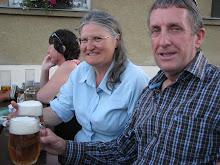
At times the coast was very rough and and other times the sun peeped out and the winds calmed down.

Many of the coastal villages like to paint their houses different colours.

This is the building belonging to the Royal Irish Constabulary. Legend has it that, when it was rebuilt after a fire, the plans got mixed up with those intended for barracks in India.

After the Ring of Kerry we continued along the coast from Skibbereen to Clonakilty. Here we took a side trip to the Drombeg Stone Circle site. It has 17 upright standing stones and a cremated teenager's remains were discovered during excavations in 1960. The circle dates from about 5th century AD being an Iron Age update of an earlier Bronze Age monument. Beside the circle are remains of a hut with this Iron Age cooking pit. A stream ran through the cooking pit and a fire was built beside it. Rocks were placed on the fire and when they were hot they were lifted into the water-filled pit and the hot water was used to cook hunks of meat. Some experiments found that the water boiled and kept hot for nearly three hours.

A street scene in Kinsale.

We had a long break at Yougal (pronounced Yawl) where we saw the Clock Gate which was built in 1777 and served as a clock tower and jail: some prisoners taken in the 1798 Rising were hung from the windows.

There were several interesting things on the town's historic walk including St Mary's Collegiate Church from 1220 and Sir Walter Raleigh's former home.
We found the National 1798 Rebellion Centre in Enniscourthy open. We took the opportunity to try to understand more of Ireland's history. There were no other visitors at the centre and the attendant had to turn on the exhibits especially for us, but unfortunately that didn't mean the heating!
We were able to learn more about the influence of the French and American revolutions and how they sparked the uprising against British rule in Wexford and the battle at Vinegar Hill.
